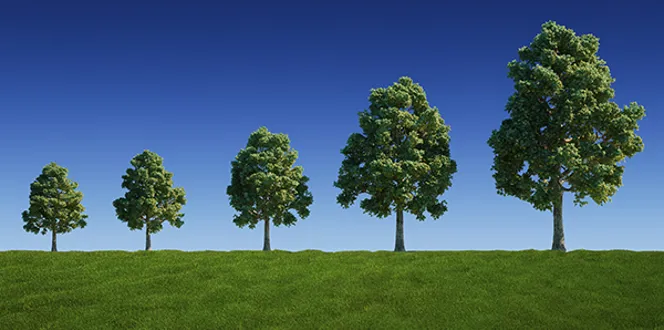People tend to want things pretty quickly today. Instant gratification is a way of life for many.
But with trees, you shouldn’t really rush the growing process. Not wanting to wait for your landscaping to be lush and full, you may focus only on planting the fastest growing trees to reach your goal.
But you might be missing out on the wonderful benefits of slower-growing trees. In fact, slow-growing and fast-growing trees each have their pros and cons.
Let’s take a look at different growth rates to give you a better understanding of how trees grow and what might best fit in your landscape.
How is the Growth Rate of a Tree Calculated?
Ready for some math?
There are actually a couple of different approaches to calculating tree growth rates.
You could repeatedly measure the height, crown spread, and stem diameter of specific trees over time. You could also measure annual shoot elongation by measuring between bud scars on branch tips.
You can get an average growth rate by taking the change in size and dividing it by the amount of time it has been growing. While this is very general, it gives you an idea.
Tree Growth Rates: What They Mean & Why You Should Care
A tree’s growth rate usually refers to its vertical increase, with canopy spread, and stem diameter growth being secondary factors.
Conditions in which trees grow, including soil depth, drainage, water, fertility, light, and wind exposure, all impact a tree’s growth rate.
While growth rate is interesting to consider, tree species can’t always be characterized by a single overall growth rate because so many factors can influence tree growth.
A healthy, happy tree that you can enjoy most in your yard is one that is planted in the right place for its needs and well cared for.
What is a Fast Growth Rate for Trees?
A tree with a fast growth rate will typically grow 25 inches or more in height annually.
What is a Moderate Growth Rate for Trees?
A tree with a medium or moderate growth rate adds 13 to 24 inches of height each year.
What is a Slow Growth Rate for Trees?
A tree with a slow growth rate gains 12 inches in height or less annually.
Choosing Between a Fast-Growing vs. Moderate/Slow-Growing Tree
Sometimes you choose trees to gain a privacy screen quickly, and other times you choose trees for their flowers, or colors, or shade.
While you may strive to plant fast-growing species because you want your landscape to fill in quickly, there are some advantages and disadvantages to consider.
Slow-growing trees are typically more substantial in their overall structure and strength, and they routinely live more than 100 years old. They produce stronger wood and have better defense mechanisms against insects and diseases. Species that grow less than 1 foot per year like white oak and Rocky Mountain Douglas fir are some of the most long-lasting.
Species that grow over 1 foot per year like the American sweetgum, coast Douglas fir and sugar maples are examples of moderate growers that also have similar traits.
Species that grow faster, like the Arborvitae ‘Green Giant,’ which grows 20 to 30 inches per year may not last as long as American sweetgum, , or coast douglas fir.
Why You Should Avoid Planting Fast-Growing Trees
You might be wondering, “Are fast-growing trees weaker?” In general, fast-growing trees do tend to be weaker.
Unfortunately, many of these trees are also more susceptible to disease and root rot. So just because they can grow and fill an area quickly doesn’t mean they have long lives and are the only trees you should focus on planting.
You always want to have a balance in your landscape. Too many fast-growing trees growing in your yard can be something that can set you up for failure later.
Fast Growing Trees to Avoid
Here are some of the fastest-growing trees you might want to avoid planting in your yard due to their weaker characteristics.
- Leyland cypress
- Bradford pear
- Virginia pine
- Cottonwood
- Black locust







